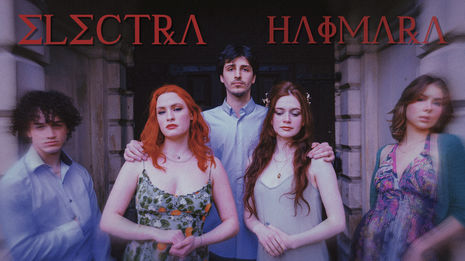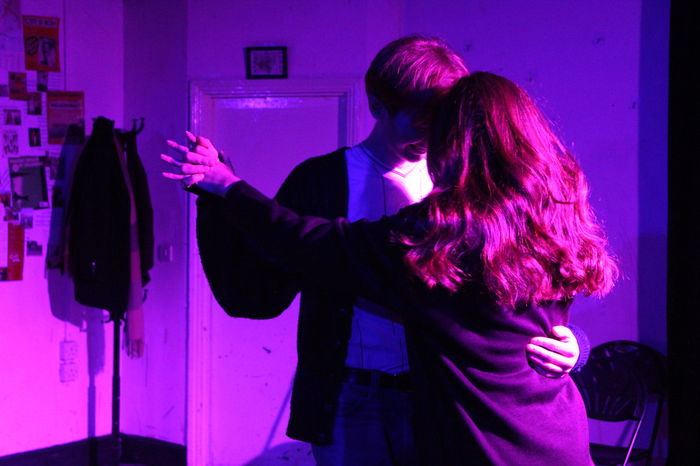A bold and daring adaptation of the ‘Oresteia’
The playwright and director of ‘Electra: Haimara’ detail their process

It started with a niggling feeling — Irisa Kwok read the Oresteia (an Ancient Greek trilogy of tragedies) and “was so drawn to it and yet felt it lacking in some way”. Then came the JSTOR search: was there a source that could justify how they felt? It turned out there were several. So after a few months of marination, all it took was a fortuitous remark from a friend wishing for an adaptation which went beyond the notion of feminine rage and a train journey back to Cambridge for Kwok to write the first draft of their take on the Oresteia. That same play, now several iterations on, is Electra: Haimara and it premieres this week at the ADC Theatre.
“Kwok discovered dimensions that had been left untapped in contemporary adaptations”
What were the sources which kickstarted the process? Research into the origins of characters saw Kwok discover dimensions that had been left untapped in contemporary adaptations. For example, they discovered that Queen Clytemnestra had been an everyday woman living on the African coast, until her husband and newborn son were killed by a man who then kidnapped her and made her his queen. Kwok saw a yet unexplored colonial trauma in the Queen’s children with the King: they would harbour an inner struggle — how would their history mingle with their lack of knowledge of their mother’s past? Another character, Pylades (the lover of one of the Queen’s sons) was described in a single source as the only person who was able to move freely between the men’s and women’s wings of the palace. To Kwok, Pylades’ role in the story was then one of “divine encouragement”, with intriguing possibilities to be found in the fluidity of his gender identity, and in an explicitly queer relationship between him and Orestes.
As they wrote the play, they realised they were restyling the classical story to “present the intensely unique feeling of how rage and grief are dealt with when one is any combination of an immigrant, or a person of colour, or LGBT+ to more traditional audiences.” Emotions took on new dimensions when emanating from specific trajectories. For example, Kwok says, “anger can’t be anger, because if we express it as it comes, we are judged, dismissed, and considered inferior.” Kwok expands on the burden some carry beneath the surface; for when feelings do eventually burst out, one has “to be prepared to be turned into nothing but a cautionary tale” because everything one does “is judged by people who have never considered what it is to live dragging the shrouded weight of a thousand years behind you”.
“The metre they’ve chosen to write in is known for ratcheting up tension”
The play is written in the structure of a Jacobean revenge tragedy, but in non-rhyming anapestic tetrameter — each line has four sections, and each section has two unstressed syllables followed by a stressed syllable. Think Twas’ The Night Before Christmas, sans-rhyming. This is part of Kwok’s striving to “fuse this idea of tradition and the more ‘avant-garde’ together,” aligned with their understanding that “a delicate balance had to be struck between appealing to convention and exploring what I really wanted to.” The metre they’ve chosen to write in is known for ratcheting up tension, making all dialogue feel like it is driving towards something, so it aligns with Kwok’s decision to condense the trilogy into a single play. By doing so, they emphasise the deep well of emotion they instinctively felt living in the characters and hit the heart of what they want to say with their writing — that “filth teaches filth…prophecy builds on prophecy… blood floods the soil.” Furthermore, by changing the original ending to instead explore the three distinct paths a person can take when faced with a great conflict, Kwok has landed on a stronger ending for their take on this ancient story — one where character arcs result in a more searching place.
The complexity of Kwok’s work is evident in their attention to detail and clarity of intention. This is echoed in the meticulous work that director Natina Nesbeth has been undertaking in the rehearsal room to bring the play to life. Nesbeth shares that she has been working hard to shift the lens to the Greek tragedy’s women “rather than the men who engineered their fates”, and in doing so have come to powerful realisations about morality. In the show there is a moment where two characters disagree about a demand from a god to kill one’s own child. Is it wrong to kill one’s own daughter, or must one simply listen to one’s instruction? For Nesbeth, it is clear that in the world of the play, “right and wrong are abstract yet paper-thin structures, so easily torn when one takes even the most miniscule of closer looks”.
Nesbeth has been deepening the staging of the play with her attention to its visual world, especially when it comes to costuming. She shares that the fabric, jewels and colours each character wears symbolises something unique to each of them. For example, Orestes wears an eye-catching sea-foam green, in sharp contrast to the deep maroons and royal purples of his prestigious family members. That his lover, Pylades, is dressed in burnt sienna signals that Orestes doesn’t belong no matter where he goes — whether in the familial or romantic plane.
It is clear that a wealth of thought and effort has gone into bringing this work from brain to page to stage. The production therefore promises to be an unmissable and thought-provoking evening at the theatre.
 Interviews / You don’t need to peak at Cambridge, says Robin Harding31 December 2025
Interviews / You don’t need to peak at Cambridge, says Robin Harding31 December 2025 News / Cambridge academics stand out in King’s 2026 Honours List2 January 2026
News / Cambridge academics stand out in King’s 2026 Honours List2 January 2026 Comment / What happened to men at Cambridge?31 December 2025
Comment / What happened to men at Cambridge?31 December 2025 News / Unions protest handling of redundancies at Epidemiology Unit30 December 2025
News / Unions protest handling of redundancies at Epidemiology Unit30 December 2025 News / Varsity’s biggest stories of 202531 December 2025
News / Varsity’s biggest stories of 202531 December 2025










